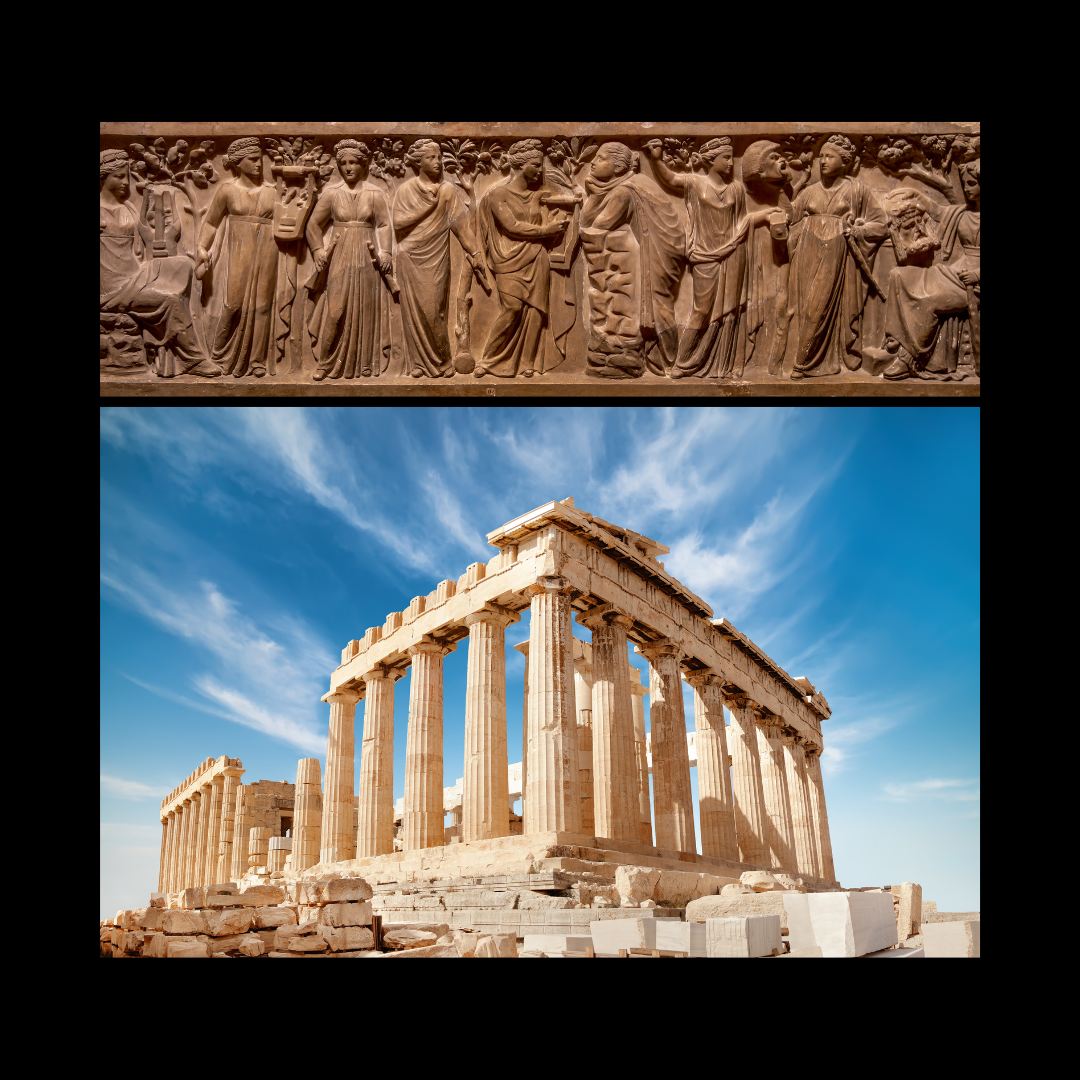
Geography and the Settlement of Greece
This remarkable culture flourished between 750 and 338 B.C.E.
[But the Anicent Greek Civilization Began Before That:Geography and the S
” Ancient Greek civilization began around 800 BCE, and its history can be divided into several periods:
-
- Minoan civilization: The first great Greek civilization, which began on the island of Crete around 3000 BCE.
- Mycenaean civilization: A Greek-speaking civilization that developed on the Greek mainland around 1500 BCE. The Mycenaeans conquered the Minoan capital and may have fought in the Trojan War.
- Greek Dark Ages: A period from around 1200–800 BCE.
- Archaic Period: A period beginning around 800 BCE, when early developments in Greek culture and society took place.
- Classical Period: A period from 480 BCE until the death of Alexander the Great in 323 BCE. The Parthenon of Athens is an example of the “classical” style of this period.
- Minoan civilization: The first great Greek civilization, which began on the island of Crete around 3000 BCE.
- Hellenistic period: A period from 323–31 BCE, when Greek power and culture spread across the Middle East and Indus Valley.
- Roman Greece: A period when Rome absorbed the Greek world into its empire” Google ai
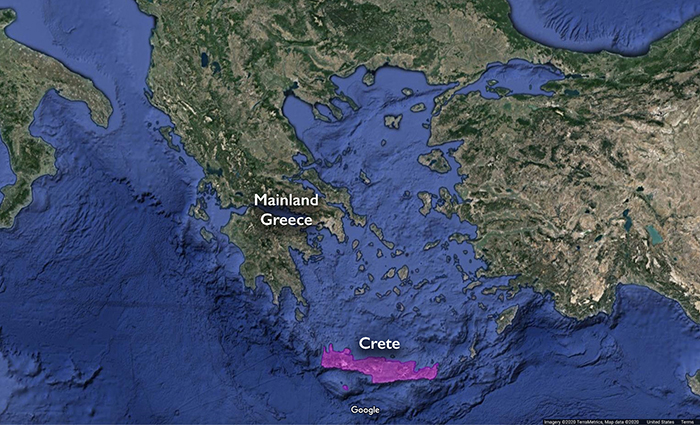
Image Credit Khan Academy
Ancient Knossus Was on the Island of Crete
The Enduring Legacy of Minoan Culture: A Journey Through Myth, Religion, and Design
The Legend of the Minotaur and the Labyrinth
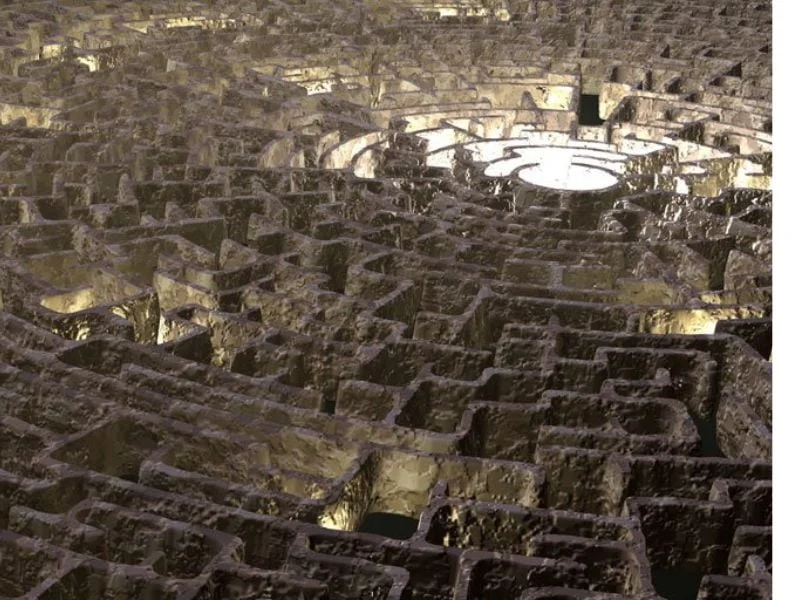
Image Credit: Knossos Palace
Ancient Greek Mythology
“The Minoan civilization was known for its impressive architecture and sophisticated art, but perhaps its most famous legacy is connected to its mythology. The legend of the Minotaur, a half-man, half-bull creature that inhabited a maze-like structure called the labyrinth, has inspired countless interpretations in literature, art, and film.
“The myth’s gruesome nature and symbolic depth continue to captivate modern audiences, reflecting our society’s values and fears. From Picasso to Neil Gaiman, contemporary artists have transformed the myth into their own vision, offering new perspectives on this ancient story.
Minoan Religion and Feminism

“Minoan religion was unique in its celebration of the divine feminine and the active involvement of women in religious practices. Its pantheon included powerful goddesses such as the earth mother goddess, who represents fertility and birth, and the snake goddess, who symbolizes wisdom, transformation, and renewal. Minoan religious rituals centered around dance, song, and offerings to the goddesses, and women played a prominent role in these activities.
“The diversity and complexity of Minoan religious practices go beyond the typical stereotypes associated with ancient societies. In Minoan culture, women held high positions of power and authority, unlike other civilizations where women were often relegated to subservient roles. Women performed as priestesses, healers, and artists and played a critical role in the overall governance of the civilization. The Minoan society’s extreme focus on the divine feminine was a stark contrast to the patriarchal structures common in other ancient civilizations.” Knossos Palace
Minoan Art and Design
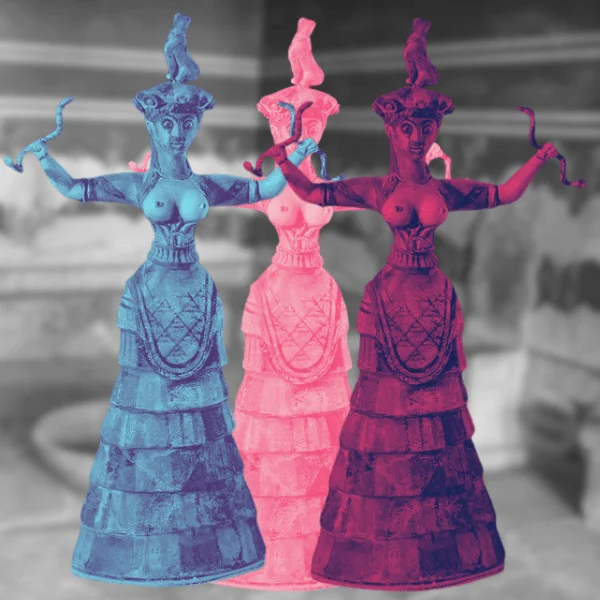
Image Credit: Knossos Palace
“Minoan art and design are renowned for their unique features that distinguish them from other ancient civilizations’ artworks. Their uses of vibrant colors, flowing lines, and intricate patterns set them apart, reflecting the Minoan people’s dedication to artistic expression. Their art is famous for depicting nature-inspired images, such as sea creatures, flowers, and birds that pay homage to their admiration for the natural world.
“Minoan frescoes, found on the walls of various palaces, showcase the civilization’s exceptional talent for capturing movement and fluidity. These wall paintings utilize a technique called the wet fresco, where the artist applies a plaster coat on the wall before it dries. The design was then applied on the still-wet plaster, creating a lasting and vibrant image. Most Minoan frescoes were painted in a lively and inviting style, giving images of colorful landscapes, people, and animal life.
“One of the most significant impacts of Minoan art and design is their influence on contemporary art and design. They have inspired artists and designers throughout history and continue to do so to this day. For instance, the Art Nouveau movement in the early 20th century drew heavily on Minoan motifs, inspiring many artists and designers of the period. The celebration of natural forms and the use of flowing lines and vibrant colors reflect the Minoan artistic tradition’s influence.” Knossos Palace
V. The Significance of Studying Minoan Culture
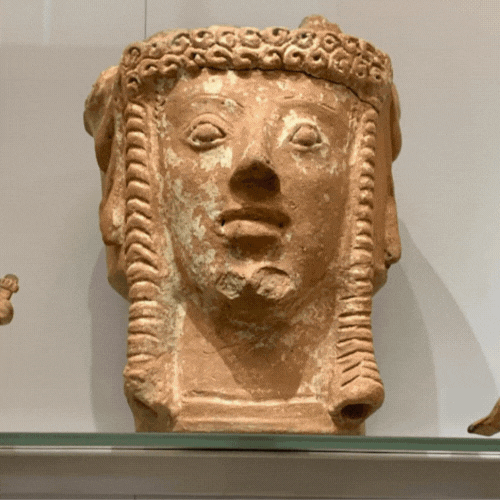
Image Credit: Knossos Palace
“Studying Minoan culture and history helps us better understand the impact of ancient civilizations on contemporary culture. Their innovative religious practices, forward-thinking feminist principles, and revolutionary artistic expression have provided a rich tapestry of inspiration upon which modern-day art and design are built.
“Recognizing the diversity and complexity of Minoan society can lead to a deeper appreciation of other ancient societies’ unique traits and cultural contributions. Studying Minoan Culture also provides a broader context for cultural preservation and intercultural dialogue, fostering a more enlightened understanding of our shared history and cultural heritage.” Knossos PalaceT
The Greek Island of Crete is Not Mentioned in the Bible Until the New Testament Book of Acts
9 Much time had been lost, and sailing had already become dangerous because by now it was after the Day of Atonement.[a] So Paul warned them, 10 “Men, I can see that our voyage is going to be disastrous and bring great loss to ship and cargo, and to our own lives also.” 11 But the centurion, instead of listening to what Paul said, followed the advice of the pilot and of the owner of the ship. 12 Since the harbor was unsuitable to winter in, the majority decided that we should sail on, hoping to reach Phoenix and winter there. This was a harbor in Crete, facing both southwest and northwest. Acts 27: 9-12
But I Have Studied Both the Biblical Stories of the Old Testament and Ancient Greek Mythology, and I Recognize Parallels Between the Two
Long Before the New Testament, Trade Routes Were Established between Ancient Greece and both Egypt and Mesopotamia. I speculate that Greek Mythology Crossed the Water Then.
How Does the Biblical Story of Creation in Genesis Compare to that of the Ancient Greeks?
“..the Greeks used the sea to establish colonies and trade relations with people from other lands.”
Life for the Ancient Greeks
“People mostly walked, or rode in carts pulled by oxen or mules. Roads were unpaved. Sharp rocks frequently shattered wooden wheels, and thick mud could stop a wagon in its tracks.
“Only wealthy people could afford to ride horses. Travelers could stop at inns on the main roads, but many inns provided only shelter. People had to bring their own food and other supplies with them. Slaves or pack animals carried bedding, food, and other necessities.
“With all these goods to take with them, the Greeks often traveled in groups, moving at a slower pace than someone traveling alone. Traveling by water was easier than traveling by land.”:max_bytes(150000):strip_icc():format(webp)/GreekPersianwar-2718eac02f064533a4a3c0e2da3fc538.jpg)
On the above map, you see that “…mainland Greece is a peninsula, made up of smaller peninsulas. Ancient Greeks were never far from the water. To the south of Greece is the Mediterranean Sea; to the east, the Aegean Sea; and to the west, the Ionian (ahy-OH-neeuhn) Sea.
“The ancient Greeks soon learned to travel by ship. The Greeks understood the dangers of the sea and treated it with great respect. Sudden storms could drive ships off course or send them smashing into the rocky shoreline. Even in open waters, ships could sink. These hazards encouraged Greek sailors to navigate close to shore, sail only during daylight, and stop at night to anchor.
Farming in Ancient Greece
“Most people in ancient Greece made their living by farming. But farming wasn’t easy in that mountainous land. Even in the plains and valleys, the land was rocky, and water was scarce. There were no major rivers flowing through Greece, and the rains fell mostly during the winter months. With limited flat land available, Greek farmers had to find the best ways to use what little land they had.
“Some farmers built wide earth steps into the hills to create more flat land for planting. A few farmers were able to grow wheat and barley, but most grew crops that needed less land, particularly grapes and olives. Greek farmers produced a lot of olive oil, which was used for cooking, to make soap, and as fuel for lamps. Ancient Greek farmers grew food for their own families.
“In addition to small vegetable gardens, many farmers planted hillside orchards of fruit and nut trees. Some Greek families kept bees to make honey. Honey was the best-known sweetener in the ancient world.
“Greek farmers also raised animals. But because cattle need wide flat lands for grazing, the ancient Greeks had to raise sheep and goats, which can graze on the sides of mountains. Sheep supplied wool for clothing, while goats provided milk and cheese.
“Greek farmers kept some oxen, mules, and donkeys for plowing and transportation. Many Greek families also kept pigs and chickens. The shortage of good farmland sometimes led to wars between Greek settlements, with each one claiming land for itself. As you will see, some settlements also had to look beyond the mainland for new sources of food and other goods.
Starting Colonies
As the populations of Greek communities increased, the existing farmland no longer produced enough food to feed all of the people. One solution was to start colonies, or settlements in distant places. Many Greek communities sent people across the sea, in search of new places to farm so that they could ship food back home. People who set up colonies are called colonists.
“The ancient Greeks made many preparations before starting a journey to a new land. Often, they began by consulting an oracle to ask the Greek gods whether their efforts would be successful. An oracle was a holy person who the Greeks believed could communicate with the gods.
“Next, the colonists gathered food and supplies.
“They took a flame from their town’s sacred fire so they could start a sacred fire in their new home.
“Greek colonists faced many hardships.
“They had to take a long sea voyage and then find a good location for their colony.
“They looked for areas with natural harbors and good farmland. They tried to avoid places where the local people might oppose the new colonies.
“Finally, they had to build their new community and make it successful.
“The Greeks established colonies over a period of more than 300 years, from 1000 to 650 B.C.E.
“The first group of settlers started a colony called Ionia, in Asia Minor, in what is present-day Turkey.”
Image Credit: Reddit
Asia Minor is next door to the Bible Lands in the Fertile Crescent in Mesopotamia. Phoenecia was another great trading center.
Notice the town Tyre on the above map, Tyre was a famous Biblical city for its prouction of purple cloth:
Tyre’s purple cloth was shipped from the massive seaport at Phonecia.

Lydia of Thyatira by Harold Copping
Now, this is where it gets interesting: There was a similar city famous for creating purple cloth in the Greek partn of Asia Minor: The town of Thyatira.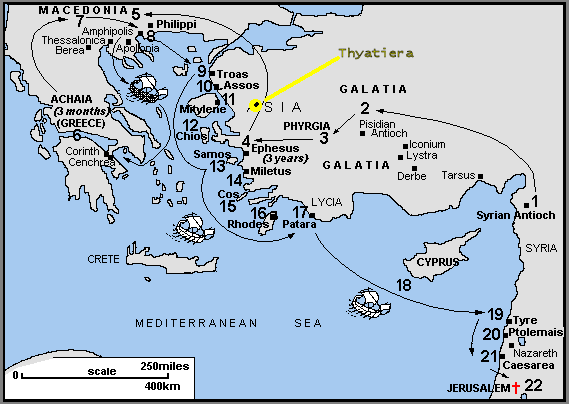
Image Credit: Wikipedia
“Thyateira (also Thyatira; Ancient Greek: Θυάτειρα) was the name of an ancient Greek city in Asia Minor, now the modern Turkish city of Akhisar (“white castle”), Manisa Province. The name is probably Lydian. It lies in the far west of Turkey, south of Istanbul and almost due east of Athens. It is about 50 miles (80 km) from the Aegean Sea.” Wikipedia
Lydia
“Lydia, whom Paul met at Philippi, is described as a “seller of purple goods” (Acts 16:14). She is further described as a native of Thyatira, a city in western Asia Minor. Thyatira was a textile center, and one of her major industries was the dyeing of purple cloth. The existence of a guild of dyers at Thyatira is attested by a number of inscriptions ….” The Encyclopedia of the Bible
I am pointing this out to make the point that Ancient Greece was connected to the Bible.
More Greek Colonies:
“Later groups started colonies in Spain, France, Italy, and Africa, and along the coast of the Black Sea.
“These colonies helped spread Greek culture. Some flourished through farming and trade.
“Colonists continued to enjoy whatever rights they once held in their home country of Greece, including the right to participate in Greek athletic games.
Trading for Needed Goods
“Many Greek settlements on the mainland relied on trade with each other to get needed goods. Some had enough farmland to meet their own needs, so they were less dependent on trade.
“The Greeks traded among the city-states, with Greek colonies, and in the wider Mediterranean region. Olive oil and pottery from the mainland were exchanged for such goods as grain, timber, and metal.
“Most goods were carried on ships owned by merchants. These ships were built of wood, with large rectangular cloth sails.
“Merchants had ships built, not for speed, but for space to hold goods. Because these ships traveled only about three to five miles per hour, journeys were long. A one-way trip from the mainland could take two months. Navigating these ships was difficult.
“The Greeks had no compasses or charts. They had only the stars to guide them. The stars could tell sailors a ship’s location, but not what hazards lay nearby. No lighthouses warned sailors of dangerous coastlines. Despite these dangers, adventurous sailors carried more and more goods, and trade flourished along the Mediterranean coast.” History Alive
 . Image Credit: History Alive Textbook
. Image Credit: History Alive Textbook
Discover more from Jacki Kellum
Subscribe to get the latest posts sent to your email.

